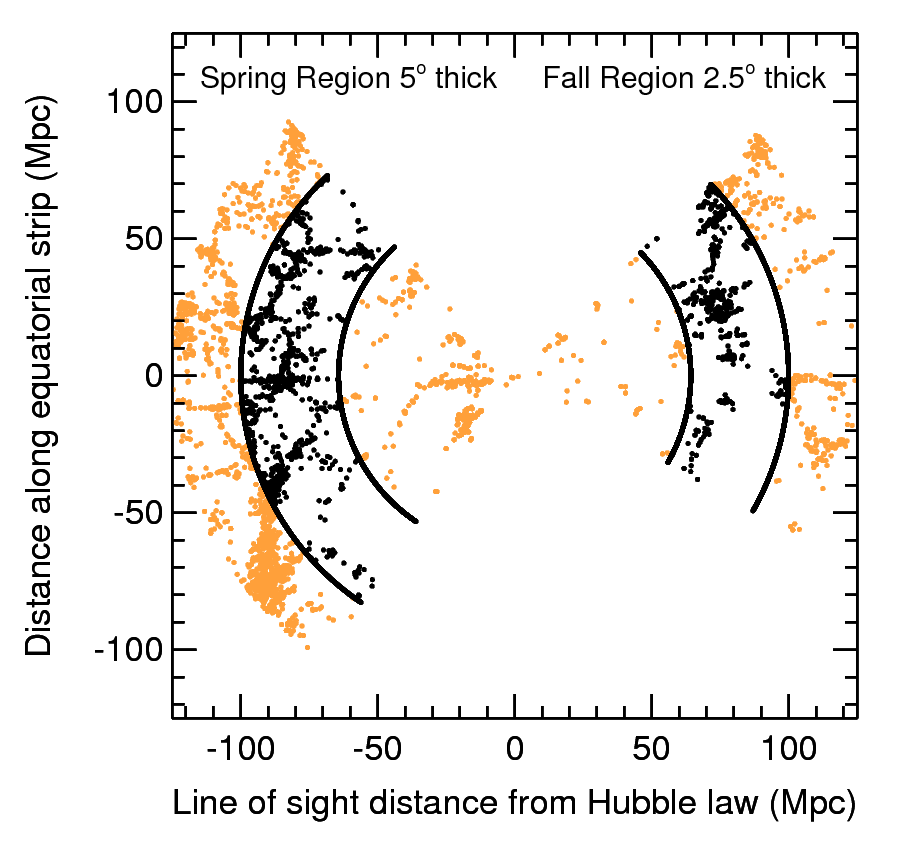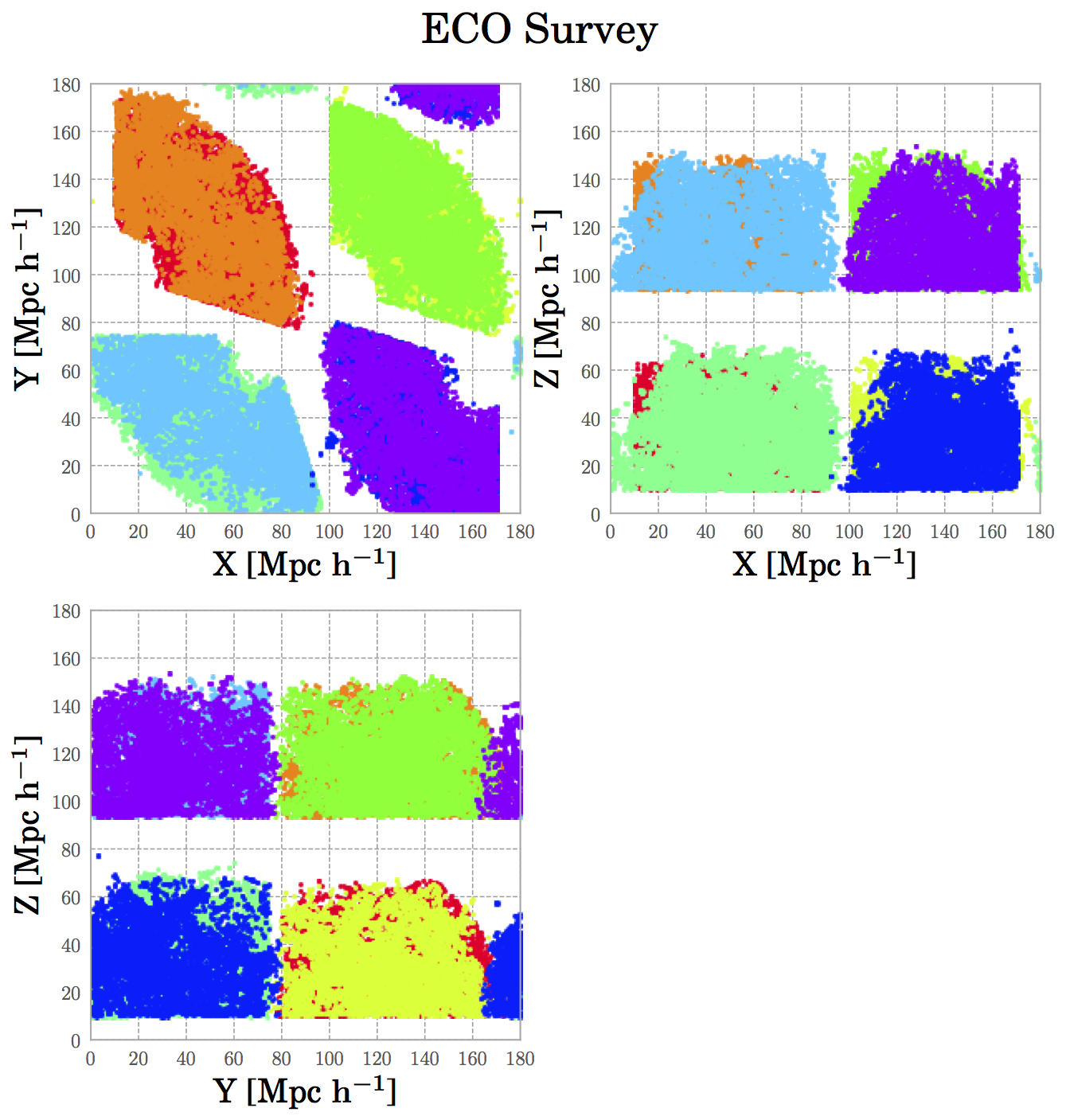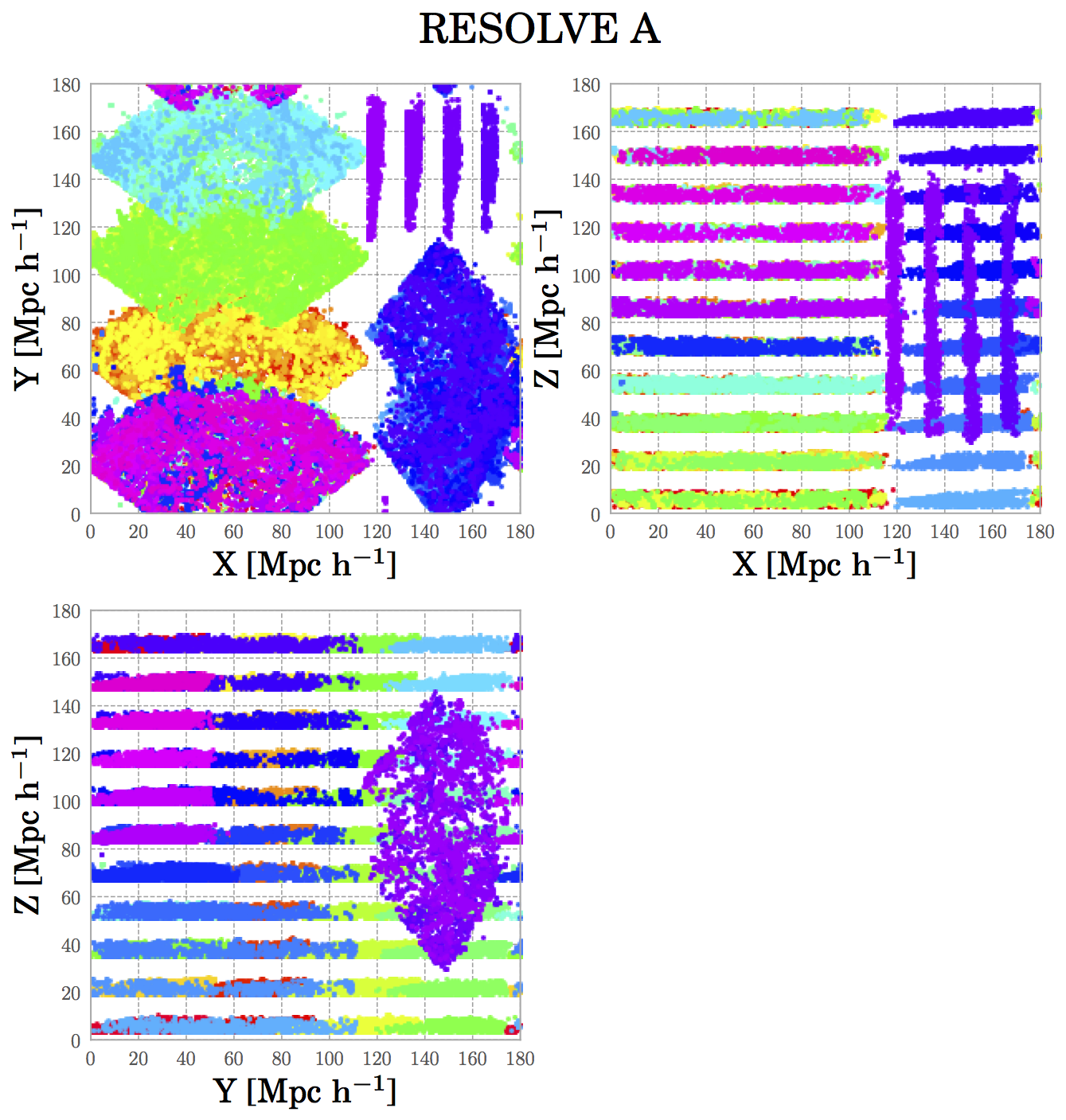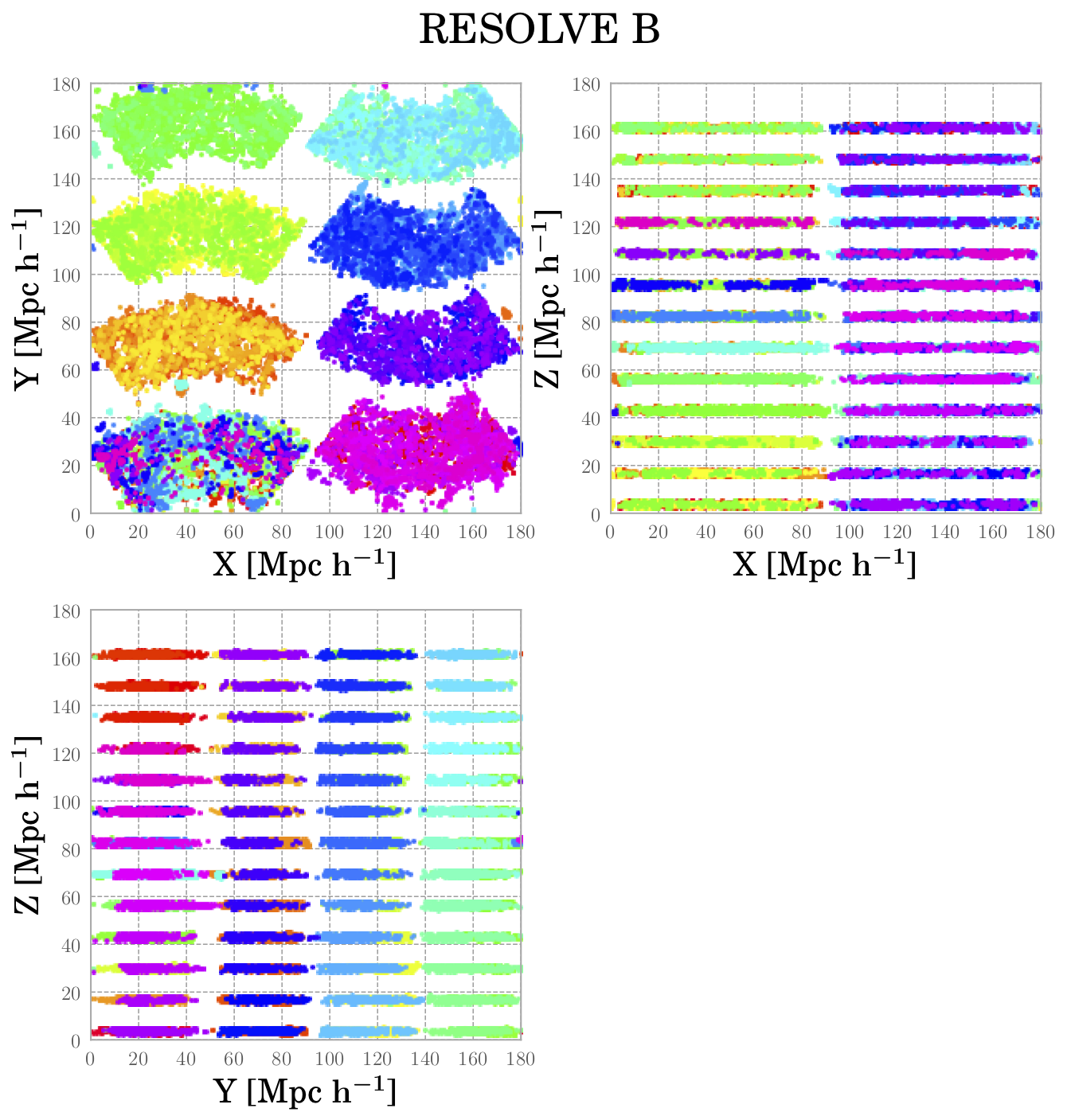Mock Catalogues¶
This is a brief overview of the different aspects of the synthetic catalogues produced for ECO RESOLVE-A and RESOLVE-B surveys
For a more comprehensive discussion on how the synthetic mocks were created, you can read the ECO and Resolve Synthetic Catalogue guide.
Table of Contents
ECO and RESOLVE¶
We construct a set of synthethic (mock) catalogues that have the same geometries as the Environmental COntext (ECO), RESOLVE-A, and RESOLVE-B galaxy surveys.
REsolved Spectroscopy Of a Local VolumE (RESOLVE) is a volume-limited census of stellar, gas, and dynamical mass as well as star formation and merging within >50,000 cubic Mpc of the nearby cosmic web, reaching down to the dwarf galaxy regime and up to structures on tens of Mpc scales such as filaments, walls, and voids.
The Environmental COntext (ECO) catalog around RESOLVE is a much larger, purely archival data set with pipelines and methods matched to RESOLVE, enabling statistically robust analyses of environmental trends and calibration of cosmic variance.

This shows the right-ascension (RA) and declination (DEC) of galaxies in RESOLVE-A and RESOLVE-B galaxy redshift surveys.

RESOLVE-A (footprint demarcated by red dashed lines) embedded within ECO (entire plot showing current footprint, with ECO-B in preparation)
For more information on how the data for the different galaxy surveys were taken, go to the Main ECO and RESOLVE website.
Constructing catalogues¶
We design the synthetic catalogues to have the exact same geometries and redshift limits as those of the ECO, RESOLVE-A, and RESOLVE-B galaxy surveys.
This is a summary of the values used to create the synthetic galaxy catalogues. These catalogues are taking a buffer regions, which is an extra buffer region along the cz (velocity) direction in redshift-space.
| Survey | RA (deg) | RA range | DEC (deg) | DEC range | zmin | zmax | Vmin (km/s) | Vmax (km/s) | Dist (Mpc) |
|---|---|---|---|---|---|---|---|---|---|
| A | (131.25, 236.25) | 105.0 | (0 ,+5) | 5 | 0.00844 | 0.0249 | 2532 | (25.32,70.02) | |
| B | (330.0 , 45.0 ) | 75.0 | (-1.25,+1.25) | 2.5 | 0.01416 | 0.024166 | 4250 | (42.5 , 72.5) | |
| ECO | (130.05, 237.45) | 107.4 | (-1, +49.85) | 50.85 | 0.00844 | 0.0249 | 2532 | (25.32,70.02) |
The next table provides the number of synthetic catalogues per cubic box of L = 180 Mpc/h, where h = 1.
| Survey | Number Mocks |
|---|---|
| A | 59 |
| B | 104 |
| ECO | 8 |
In order to run the Friends-of-Friends (FoF) algorithm and put galaxies into galaxy groups, we have to choose a set of linking lengths. The set of linking lengths used for this analyses are
| l_perp | l_para |
|---|---|
| 0.07 | 1.1 |
Note
The units for the linking lengths are in terms of the mean inter-galaxy separation of the simulation.
Distribution of catalogues in simulation box¶
In order to maximize the number of catalogues per simulation, we have to fit as many catalogues as we can, while keeping a distance of ~10 Mpc/h between catalogues. We chose this distance of 10 Mpc/h in order to avoid using the same galaxy for different catalogues, and also to make the catalogues as independent from each other as possible.

This figure shows how the catalogues for ECO surveys are organized within the simulation box used for this analysis.

And this figure shows the distribution of synthetic RESOLVE-A catalogues in the simulation box!

Finally, this figure shows the Cartesian representation of the positions of galaxies in the RESOLVE-B survey.
Downloading and reading in data from catalogues¶
The mock catalogues are located at http://lss.phy.vanderbilt.edu/groups/data_eco_vc/Mock_Catalogues/.
These catalogues can be downloaded as tar files, and be read by the Python package Pandas.
After having downloaded your file, you can read them in the following way:
#! /usr/bin/env python
import pandas as pd
import os
def reading_catls(filename, catl_format='.hdf5'):
"""
Function to read ECO/RESOLVE catalogues.
Parameters
----------
filename: string
path and name of the ECO/RESOLVE catalogue to read
catl_format: string, optional (default = '.hdf5')
type of file to read.
Options:
- '.hdf5': Reads in a catalogue in HDF5 format
Returns
-------
mock_pd: pandas DataFrame
DataFrame with galaxy/group information
Examples
--------
# Specifying `filename`
>>> filename = 'ECO_catl.hdf5'
# Reading in Catalogue
>>> mock_pd = reading_catls(filename, format='.hdf5')
>>> mock_pd.head()
x y z vx vy vz \
0 10.225435 24.778214 3.148386 356.112457 -318.894409 366.721832
1 20.945772 14.500367 -0.237940 168.731766 37.558834 447.436951
2 21.335835 14.808488 0.004653 967.204407 -701.556763 -388.055115
3 11.102760 21.782235 2.947002 611.646484 -179.032089 113.388794
4 13.217764 21.214905 2.113904 120.689598 -63.448833 400.766541
loghalom cs_flag haloid halo_ngal ... cz_nodist vel_tot \
0 12.170 1 196005 1 ... 2704.599189 602.490355
1 11.079 1 197110 1 ... 2552.681697 479.667489
2 11.339 1 197131 1 ... 2602.377466 1256.285409
3 11.529 1 199056 1 ... 2467.277182 647.318259
4 10.642 1 199118 1 ... 2513.381124 423.326770
vel_tan vel_pec ra_orig groupid M_group g_ngal g_galtype \
0 591.399858 -115.068833 215.025116 0 11.702527 1 1
1 453.617221 155.924074 182.144134 1 11.524787 4 0
2 1192.742240 394.485714 182.213220 1 11.524787 4 0
3 633.928896 130.977416 210.441320 2 11.502205 1 1
4 421.064495 43.706352 205.525386 3 10.899680 1 1
halo_rvir
0 0.184839
1 0.079997
2 0.097636
3 0.113011
4 0.057210
"""
## Checking if file exists
if not os.path.exists(filename):
msg = '`filename`: {0} NOT FOUND! Exiting..'.format(filename)
raise ValueError(msg)
## Reading file
if catl_format=='.hdf5':
mock_pd = pd.read_hdf(filename)
else:
msg = '`catl_format` ({0}) not supported! Exiting...'.format(catl_format)
raise ValueError(msg)
return mock_pd
def main():
# Specifying filename
filename = 'ECO_catl.hdf5'
# Reading in ECO/RESOLVE catalogue
mock_pd = reading_catls(filename)
if __name__=='__main__':
main()
Description of the fields in the catalogues¶
Each mock catalogues contains information about the galaxy, group galaxy, host halo, and more. We will denote *dark matter* as DM.
Note
The descriptions for the variables are somewhat long, so don’t forget to scroll to the right to see more.
Main Galaxy Properties¶
| Field | Description | Units |
|---|---|---|
ra |
Right Ascension | degrees |
dec |
Declination | degrees |
cz |
Velocity of the galaxy (**with redshift-space distortions) | km/s |
M_r |
r-band absolute magnitude of the galaxy | magnitudes |
haloid |
Dark matter halo ID, as taking from the simulation | None |
loghalom |
logarithmic value of the DM’s mass | log(Msun/h) where h=1 |
halo_ngal |
Total number of galaxies in DM halo. Number of galaxies in the mock may differ from this value | None |
cs_flag |
Type of galaxy. Halo central = 1, Halo satellite = 0 | None |
cz_nodist |
Velocity of the galaxy (without redshift-space distortions) | km/s |
dist_c |
Real distance between halo’s central galaxy and the galaxy. | Mpc/h with h=1 |
vel_tot |
Total velu for peculiar velocity | km/s |
vel_tan |
Tangential component of the peculiar velocity | km/s |
morph |
Galaxy’s morphology. ‘LT’: Late Type; ‘ET’: Early type. Used either goodmorph (ECO) or MORPH (RESOLVE) keys. ‘-9999’ if no matched galaxy | None |
logmstar |
Log value of galaxy’s stellar mass. Used either ‘rpgoodmstarsnew’ (ECO) or ‘MSTARS’ (RESOLVE) keys in the files | log(Msun) |
rmag |
r-band apparent magnitude. Used either ‘rpsmoothrestrmagnew’ (ECO) or ‘SMOOTHRESTRMAG’ (RESOLVE) keys in the files. | magnitudes |
umag |
u-band apparent magnitude. Used either ‘rpsmoothrestumagnew’ (ECO) or ‘SMOOTHRESTUMAG’ (RESOLVE) keys in the files. | magnitudes |
fsmgr |
Stellar mass produced over last Gyr divided by pre-existing stellar mass from new model set. Used ‘rpmeanssfr’ (ECO) or ‘MODELFSMGR’ (RESOLVE) keys. | (1/Gyr) |
survey_flag |
Survey name, from which the properties of the real matched galaxy were extracted. | None |
u_r |
Color of the matched galaxy, i.e. (umag - rmag) |
magnitudes |
mhi |
HI mass in galaxy. Used the predicted HI massed (matched to the ECO file, i.e. eco_wresa_050815.dat) and the key “MHI” (RESOLVE). To compute MHI masses using ECO, we used the formula: 10^(MHI + logmstar) |
Msun |
groupid |
Group ID, to which the galaxy belongs after running Berlind2006 FoF group finder. | None |
g_ngal |
Number of galaxies in a group of galaxies | None |
halo_rvir |
Virial radius of the DM halo, to which the galaxy belongs. | Mpc/h with h = 1. |
M_group |
Abundance matched mass of the galaxy group. This was calculated by assuming a monotonic relation between DM halo mass logM_halo and the group total luminosity. For RESOLVE-B, we used a modified version of the ECO group luminosity function. |
Msun/h with h = 1 |
g_galtype |
Type of galaxy. Group central = 1, Group satellite = 0 | None |
Note
The relationship between velocities (cz’s’) is the following:
(cz - cz_nodist)^2 + (vel_tan)^2 = (vel_tot)^2.
Halos Filaments¶
Author: Roberto Gonzales [regonzar@astro.puc.cl or regonzar@oddjob.uchicago.edu]
Affiliation: The University of Chicago, Universidad Católica de Chile
This file includes data about the filaments found in the simulation box used for these synthetic catalogues.
The catalogue can be found at http://lss.phy.vanderbilt.edu/groups/data_eco_vc/Halo_Filaments/.
| Field | Description | Units |
|---|---|---|
Halo ID |
Halo ID number for the given DM halo in the simulation box. | |
log(MHalo) |
Logarithmic value of the DM halo’s mass, as \(log(MHalo)\) | log(Msun/h) with h = 1 |
ID/Type |
ID of the DM halo’s environment. ‘0’: Not in a filament; ‘1’: filament node; ‘2’: part of a filament skeleton; ‘3’: within a clode radius of a filament. | |
Fil |
ID of the halo’s filament. (-1 if not in a filament) | |
Fil. Quality |
Quality of the filament, i.e. probability that the filament is real |